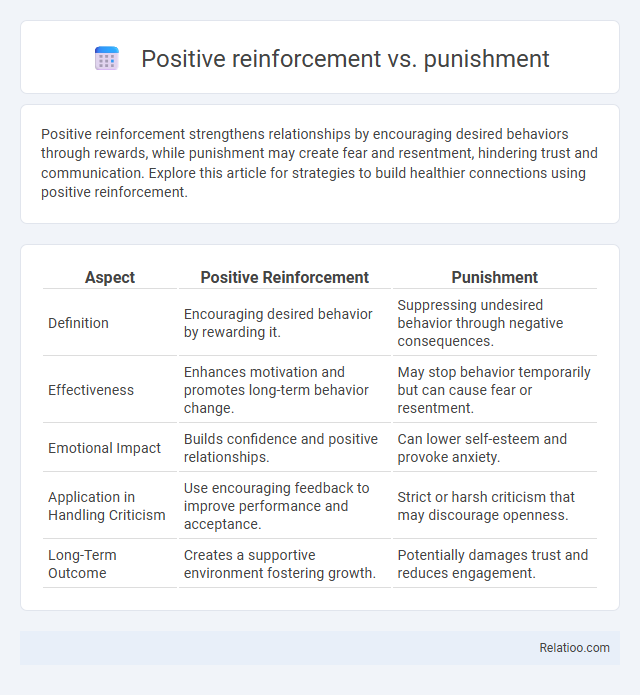Positive reinforcement strengthens relationships by encouraging desired behaviors through rewards, while punishment may create fear and resentment, hindering trust and communication. Explore this article for strategies to build healthier connections using positive reinforcement.
Table of Comparison
| Aspect | Positive Reinforcement | Punishment |
|---|---|---|
| Definition | Encouraging desired behavior by rewarding it. | Suppressing undesired behavior through negative consequences. |
| Effectiveness | Enhances motivation and promotes long-term behavior change. | May stop behavior temporarily but can cause fear or resentment. |
| Emotional Impact | Builds confidence and positive relationships. | Can lower self-esteem and provoke anxiety. |
| Application in Handling Criticism | Use encouraging feedback to improve performance and acceptance. | Strict or harsh criticism that may discourage openness. |
| Long-Term Outcome | Creates a supportive environment fostering growth. | Potentially damages trust and reduces engagement. |
Understanding Positive Reinforcement
Positive reinforcement involves adding a desirable stimulus after a behavior to increase the likelihood of its recurrence, such as giving praise or rewards. Unlike punishment, which aims to decrease unwanted behavior by introducing unpleasant consequences, positive reinforcement strengthens behavior by emphasizing positive outcomes. Understanding positive reinforcement is crucial for effective behavior management in educational settings, workplace motivation, and animal training.
Defining Punishment in Behavior Management
Punishment in behavior management refers to introducing an adverse consequence or removing a desirable stimulus following an undesired behavior to decrease its occurrence. Positive reinforcement involves adding a rewarding stimulus to increase the likelihood of a behavior, while punishment aims to reduce unwanted actions through negative outcomes. Understanding the distinction between these methods helps you apply effective strategies to shape behavior constructively.
Key Differences Between Positive Reinforcement and Punishment
Positive reinforcement increases desired behaviors by offering rewards or incentives, while punishment aims to decrease unwanted behaviors through negative consequences. Your approach to behavior modification should consider that positive reinforcement builds motivation and long-term change, whereas punishment may cause fear or avoidance without teaching alternative behaviors. Understanding these key differences helps create effective strategies tailored to encourage positive actions and reduce negative ones.
Psychological Principles Behind Positive Reinforcement
Positive reinforcement operates on the psychological principle of increasing desired behavior by presenting a rewarding stimulus immediately after the behavior occurs, strengthening the behavior's frequency over time. In contrast, punishment seeks to decrease undesired behavior by applying an aversive consequence, while negative reinforcement involves removing an unpleasant stimulus to enhance behavior. Understanding the neurobiological mechanisms of dopamine release and reward pathways highlights why positive reinforcement effectively encourages learning and behavioral change.
Effects of Punishment on Behavior
Punishment often suppresses undesirable behavior temporarily but can lead to negative emotional responses such as fear and anxiety, which may undermine learning and motivation. Unlike positive reinforcement, which strengthens desirable behavior by adding rewarding stimuli, punishment risks increasing aggression and avoidance behaviors without teaching alternative positive actions. Effective behavior modification typically favors positive reinforcement to encourage lasting behavioral change while minimizing adverse psychological effects associated with punishment.
Benefits of Positive Reinforcement
Positive reinforcement enhances learning and behavior by rewarding desired actions, leading to increased motivation and long-term retention. Unlike punishment, which may create fear or resistance, positive reinforcement fosters a supportive environment that encourages continuous improvement. This approach is especially effective in educational settings, workplace management, and child development, promoting cooperation and emotional well-being.
Negative Outcomes Associated with Punishment
Punishment often leads to negative outcomes such as increased fear, anxiety, and aggression, which can undermine your goal of promoting desired behavior. Unlike positive reinforcement, which encourages repetition of good behavior through rewards, punishment may cause avoidance or resentment, reducing overall compliance and motivation. Understanding these adverse effects highlights the importance of choosing reinforcement strategies that foster long-term positive behavior.
Real-life Examples: Positive Reinforcement vs. Punishment
Positive reinforcement strengthens desired behavior by rewarding actions, such as giving a child praise or treats for completing homework, which increases the likelihood of repetition. Punishment involves introducing unpleasant consequences, like a time-out or loss of privileges for misbehavior, aiming to decrease undesirable actions but often leading to negative emotional outcomes. Real-life examples show positive reinforcement promotes long-term behavior change by motivating individuals, while punishment may stop behavior quickly but does not teach appropriate alternatives effectively.
Choosing the Right Approach for Long-term Change
Choosing the right approach for long-term change depends on understanding the distinct impacts of positive reinforcement and punishment on behavior. Positive reinforcement strengthens desired behaviors by rewarding your actions, leading to increased motivation and sustained improvements. Punishment may suppress unwanted behaviors temporarily but often fails to promote lasting change and can create negative associations or resistance.
Recommendations for Effective Behavior Modification
Effective behavior modification relies on consistent positive reinforcement, which strengthens desired behaviors by rewarding specific actions promptly and meaningfully. Punishment can suppress unwanted behaviors but often leads to negative emotional responses and should be used sparingly, focusing on clear, immediate consequences combined with explanations. A balanced approach incorporating positive reinforcement with strategic, minimal use of punishment maximizes behavior change while promoting long-term motivation and psychological well-being.

Infographic: Positive reinforcement vs Punishment
 relatioo.com
relatioo.com